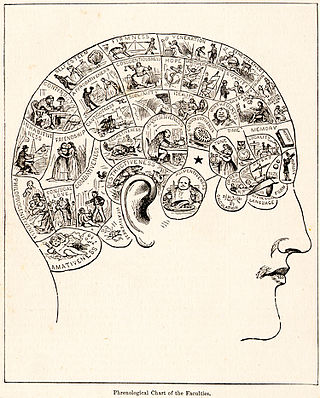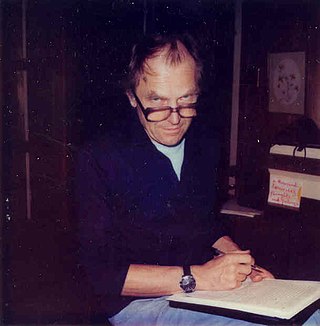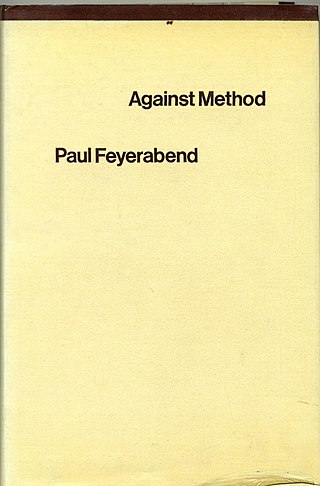
Falsifiability is a deductive standard of evaluation of scientific theories and hypotheses, introduced by the philosopher of science Karl Popper in his book The Logic of Scientific Discovery (1934). A theory or hypothesis is falsifiable if it can be logically contradicted by an empirical test.

Pseudoscience consists of statements, beliefs, or practices that claim to be both scientific and factual but are incompatible with the scientific method. Pseudoscience is often characterized by contradictory, exaggerated or unfalsifiable claims; reliance on confirmation bias rather than rigorous attempts at refutation; lack of openness to evaluation by other experts; absence of systematic practices when developing hypotheses; and continued adherence long after the pseudoscientific hypotheses have been experimentally discredited.

Imre Lakatos was a Hungarian philosopher of mathematics and science, known for his thesis of the fallibility of mathematics and its "methodology of proofs and refutations" in its pre-axiomatic stages of development, and also for introducing the concept of the "research programme" in his methodology of scientific research programmes.
Planner is a programming language designed by Carl Hewitt at MIT, and first published in 1969. First, subsets such as Micro-Planner and Pico-Planner were implemented, and then essentially the whole language was implemented as Popler by Julian Davies at the University of Edinburgh in the POP-2 programming language. Derivations such as QA4, Conniver, QLISP and Ether were important tools in artificial intelligence research in the 1970s, which influenced commercial developments such as Knowledge Engineering Environment (KEE) and Automated Reasoning Tool (ART).

Paul Karl Feyerabend was an Austrian philosopher best known for his work in the philosophy of science. He started his academic career as lecturer in the philosophy of science at the University of Bristol (1955–1958); afterwards, he moved to the University of California, Berkeley, where he taught for three decades (1958–1989). At various points in his life, he held joint appointments at the University College London (1967–1970), the London School of Economics (1967), the FU Berlin (1968), Yale University (1969), the University of Auckland, the University of Sussex (1974), and, finally, the ETH Zurich (1980–1990). He gave lecture series at Stanford University (1967), the University of Kassel (1977) and the University of Trento (1992).
Normal science, identified and elaborated on by Thomas Samuel Kuhn in The Structure of Scientific Revolutions, is the regular work of scientists theorizing, observing, and experimenting within a settled paradigm or explanatory framework. Regarding science as puzzle-solving, Kuhn explained normal science as slowly accumulating detail in accord with established broad theory, without questioning or challenging the underlying assumptions of that theory.

The Latin phrase odium theologicum is the name originally given to the often intense anger and hatred generated by disputes over theology. It has also been adopted to describe non-theological disputes of a rancorous nature.
The following outline is provided as an overview of and topical guide to the scientific method:
The historiography of science or the historiography of the history of science is the study of the history and methodology of the sub-discipline of history, known as the history of science, including its disciplinary aspects and practices and the study of its own historical development.
In philosophy of science and epistemology, the demarcation problem is the question of how to distinguish between science and non-science. It also examines the boundaries between science, pseudoscience and other products of human activity, like art and literature and beliefs. The debate continues after more than two millennia of dialogue among philosophers of science and scientists in various fields. The debate has consequences for what can be termed "scientific" in topics such as education and public policy.

The sociology of scientific knowledge (SSK) is the study of science as a social activity, especially dealing with "the social conditions and effects of science, and with the social structures and processes of scientific activity." The sociology of scientific ignorance (SSI) is complementary to the sociology of scientific knowledge. For comparison, the sociology of knowledge studies the impact of human knowledge and the prevailing ideas on societies and relations between knowledge and the social context within which it arises.
The science wars were a series of scholarly and public discussions in the 1990s over the social place of science in making authoritative claims about the world. HighBeam Encyclopedia, citing the Encyclopedia of Science and Religion, defines the science wars as the discussions about the "way the sciences are related to or incarnated in culture, history, and practice[...] [which] came to be called a 'war' in the mid 1990s because of a strong polarization over questions of legitimacy and authority. One side [...] is concerned with defending the authority of science as rooted in objective evidence and rational procedures. The other side argues that it is legitimate and fruitful to study the sciences as institutions and social-technical networks whose development is influenced by linguistics, economics, politics, and other factors surrounding formally rational procedures and isolated established facts."

Against Method: Outline of an Anarchistic Theory of Knowledge is a 1975 book by Austrian-born philosopher of science Paul Feyerabend. The central thesis of the book is that science should become an anarchic enterprise. In the context of the work, the term "anarchy" refers to epistemological anarchy, which does not remain within one single prescriptive scientific method on the grounds that any such method would restrict scientific progress. The work is notable in the history and philosophy of science partially due to its detailed case study of Galileo's hypothesis that the earth rotates on its axis and has since become a staple reading in introduction to philosophy of science courses at undergraduate and graduate levels.
Indeterminacy in concurrent computation is concerned with the effects of indeterminacy in concurrent computation. Computation is an area in which indeterminacy is becoming increasingly important because of the massive increase in concurrency due to networking and the advent of many-core computer architectures. These computer systems make use of arbiters which gives rise to indeterminacy.
In computer science, the Actor model, first published in 1973, is a mathematical model of concurrent computation. This article reports on the middle history of the Actor model in which major themes were initial implementations, initial applications, and development of the first proof theory and denotational model. It is the follow on article to Actor model early history which reports on the early history of the Actor model which concerned the basic development of the concepts. The article Actor model later history reports on developments after the ones reported in this article.
Theory choice was a main problem in the philosophy of science in the early 20th century, and under the impact of the new and controversial theories of relativity and quantum physics, came to involve how scientists should choose between competing theories.
A research program is a professional network of scientists conducting basic research. The term was used by philosopher of science Imre Lakatos to blend and revise the normative model of science offered by Karl Popper's The Logic of Scientific Discovery and the descriptive model of science offered by Thomas Kuhn's The Structure of Scientific Revolutions. Lakatos found falsificationism impractical and often not practiced, and found normal science—where a paradigm of science, mimicking an exemplar, extinguishes differing perspectives—more monopolistic than actual.

Carl Eddie Hewitt was an American computer scientist who designed the Planner programming language for automated planning and the actor model of concurrent computation, which have been influential in the development of logic, functional and object-oriented programming. Planner was the first programming language based on procedural plans invoked using pattern-directed invocation from assertions and goals. The actor model influenced the development of the Scheme programming language, the π-calculus, and served as an inspiration for several other programming languages.
An index list of articles about the philosophy of science.
Bold hypothesis or bold conjecture is a concept in the philosophy of science of Karl Popper, first explained in his debut The Logic of Scientific Discovery (1935) and subsequently elaborated in writings such as Conjectures and Refutations: The Growth of Scientific Knowledge (1963). The concept is nowadays widely used in the philosophy of science and in the philosophy of knowledge. It is also used in the social and behavioural sciences.







